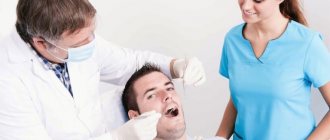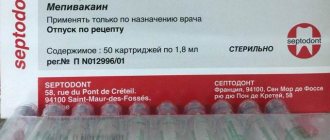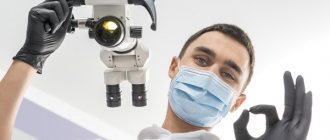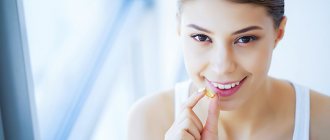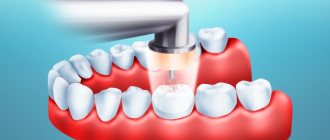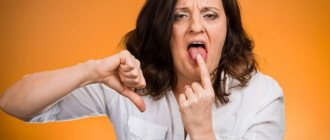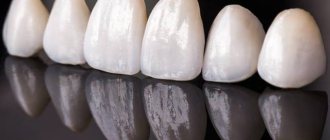Author: Sheplev Boris Valentinovich, Doctor of Medical Sciences Center for Postgraduate Education "DentMaster", Novosibirsk
This material opens a series of scientific and practical articles on various aspects of the use of an operating microscope in dentistry. The cycle is based on a report made at the Anniversary Dental Congress PULP FICTION (Novosibirsk, June 4-6, 2009). The first part provides a brief historical perspective, an overview of dental mirrors and clinical examples from everyday practice.
Magnification and lighting
Dental treatment using a magnifying glass or head-mounted optics (Fig. 1) has significant advantages over the “naked” eye. In endodontics, Harry Carr was the first to propose the use of an operating microscope: in addition to magnification, the microscope illuminates the object better than a traditional dental lamp (Fig. 2).
Fig.1. Zeiss glasses
Fig.2. Optimizing object lighting
Today, microscope-oriented practice (Fig. 3) is the main priority and the main trend in the development of modern dentistry, the main principles of which are preventive and minimally invasive methods.
Fig.3. OPMI pico microscope from Carl Zeiss equipped with a beam splitter, video adapters and a camera
Carrying out endodontic and restorative manipulations using an operating microscope (Fig. 4, 5) increases the likelihood of successful treatment and optimizes the dentist’s work process.
Ergonomics: • Comfort for the eyes. • Comfortable position. Video!
| Rice. 4, 5. At a dental appointment in microscope-oriented practice, 90% of manipulations are carried out indirectly | |
Watch the video!
Dental mirrors
The main differences between dental mirrors for working with an operating microscope are their glare-free nature and the ability not to distort the object.
- Glare-free. As a rule, anti-reflective properties are ensured by applying a reflective layer to the surface of the glass, and not under it. To protect the mirror surface from scratches and extend its service life, rhodium alloy coating is used.
- No distortion. The mirror must be flat, perfectly focused, must display the object once and not blur the contours.
Visual illustration (Fig. 6): HR Front mirror (R?DER, Germany), Aesculap mirrors (Germany)
Fig.6. RaCe NiTi instrument and flat mirror for microscope. Please note that the tip of the file is directly reflected in the mirror due to the fact that the reflective layer is applied ON the surface of the glass, and not under it
The range of dental mirrors that meet these requirements is quite wide. Below are some examples with characteristic features: special purpose mirrors (Fig. 7c, and general purpose mirrors (Fig. 6, 7a, 9).
Below are some examples with characteristic features: special purpose mirrors (Fig. 7c, and general purpose mirrors (Fig. 6, 7a, 9).
- Double-ended mirror with rhodium coating and endodontic ruler (Fig. 7 a). Its use optimizes the treatment process: the assistant wipes one of the mirrors, and the dentist can work on the other without interruption (watch the video demonstrating the ergonomics of this approach).
- Various clinical situations require appropriately sized instruments for specific tasks (Fig. 7 b). Macro mirror, 50 mm in diameter, is used for examinations and large restorations in the anterior region.
- Special microsurgical (endodontic) mirror MEGAmicro (HAHNENKRATT, Germany). It can be round or rectangular in shape (Fig. 7 c, d). Typically, the mirror layer is polished metal; and in this example it is a precious stone. This unique feature improves the quality of pictures.
| Fig.7 a-d. Anti-reflective dental mirrors for working with a microscope. Pay attention to the variety of designs, sizes and shapes |
- Harry Carr's round micro-mirror with increased light output: a special alloy is applied to the surface, reflecting 2 times more light. Expensive, used for documentation.
| Fig.8 a, b. Harry Carr endodontic mirror. Compare the pictures: the bottom one was taken using this mirror |
Fig.9. EverClear anti-splash mirror from I-DENT (see clinical example of use below)
Sterilization
Sterilization is the process of destroying a huge number of germs and viruses using physical or chemical influences.
Almost every person has been to the dentist at least once. And many people ask the same question:
- Are all instruments thoroughly sterilized?
- How are dental instruments generally sterilized?
To begin with, it is necessary to note what sterilization is.
Undoubtedly, everyone knows that all medical instruments must be sterile and disinfected.
Dental instruments are sterilized in two stages:
- the first is pre-sterilization cleaning,
- the second is sterilization,
which is carried out in two ways:
- chemical;
- physical.
The chemical method uses various chemicals, while the physical method uses special sterilizers.
During the first stage, the instruments are treated with a solution of hydrogen peroxide (0.5%), then thoroughly washed with water and left in a hot solution that contains a special detergent for 10-15 minutes. After this, you need to wash all the tools again and rinse with distilled water. After such treatment, it is necessary to control the quality of cleaning. Most often, a test with benzidine sulfate or benzidine hydrochloride, an amidopyrine test and an ortho-tolidine test are used for testing.
The sterilization itself can be carried out with dry hot air.
With this air it is necessary to sterilize all instruments, in addition to mirrors and special tips for drills, within an hour. Sterilization takes place at a temperature of 180 degrees in special trays or bags. The same instruments can be sterilized using a solution of hydrogen peroxide (6%), then they must be immersed in sterile water.
If the instruments are not used, they remain sterile for three days.
Sterile instruments should be stored on a sterile cloth placed in a special sterile container.
Dental mirrors and handpieces for drills are sterilized in a different way. The mirrors, having previously been cleaned, are disinfected with a solution of hydrogen peroxide (3%) for at least an hour. And the tips for the drills are wiped with a gauze swab moistened with a special solution of chloramine (1%) and a solution of formaldehyde (3%). The interval between wipes is 10-15 minutes.
Dental instruments can be disinfected during the second stage using an air sterilizer (at a temperature of 180°C for an hour or at a temperature of 160°C for 150 minutes), a steam sterilizer (at a temperature of 132°C for 20 minutes or at a temperature of 120° C for 45 minutes), or in a glass-perlene sterilizer designed for small dental instruments.
You should also disinfect surfaces in your dental office, including equipment, faucets, and door handles. In addition, the dental office must have a bactericidal ultraviolet irradiator, with which you can carry out quartz treatment in the office.
In no case should you forget about hand disinfection. Despite the fact that medical personnel always work in disposable sterile gloves, they are required to thoroughly clean their hands, since a huge number of microorganisms accumulate on them.
There are three types of hand treatment:
- normal washing
- hand hygiene,
- surgical treatment of hands.
Having paid special attention and learned more about the disinfection and sterilization of medical instruments, surfaces, premises, etc., we can safely say that the dentist’s office is one of the cleanest and sterile places where treatment and disinfection are carried out very often.
Clinical examples. Video
Minimal invasion: micro-mirror
Initial situation: missing 3.6 tooth, preparatory stage before implantation, sanitation of the oral cavity. A carious change in the tissues of the proximal surface of the 3.5 tooth was revealed (Fig. 10-11).
Fig. 10. Clinical situation
| Fig. 11. Revision of the proximal surface of tooth 35 using a micro-mirror |
Preparation: It is not possible to prepare only the proximal surface with a conventional handpiece, since there is not enough space to accommodate the collet and bur.
The use of an ultrasonic nozzle and a micro-mirror allows for minimally invasive treatment of the approximal class II cavity without bringing the preparation to the occlusal surface (Fig. 12-15).
| Fig.12-15. To remove carically damaged tissues, ultrasonic approximal attachments are used; for visual control of the cleanliness of the preparation - micro-mirror MEGAmicro (HAHNENKRATT, Germany) |
Direct restoration: surface etching with 37% H3PO4 followed by adhesive treatment (Fig. 16, 17); applying a flowable composite to the bottom of the cavity using a special nozzle (Fig. 18, 19); layer-by-layer application of a dual-curing composite, activation of light polymerization and finished composite restoration of 3.5 teeth (Fig. 20-22). Visual control is carried out through a micro-mirror.
| Fig. 16, 17. Etching with 37% H3PO4 and adhesive preparation of the cavity of the 35th tooth | |
| Rice. 18, 19. Special nozzle for applying flowable composite |
| Fig.20. Adding composite | Fig.21. Light polymerization |
Fig.22. Finished restoration
To learn the technique of minimally invasive caries treatment using a micro-mirror, watch the video
To see or not to see? Mirror EverClear
When carrying out various dental procedures (especially when working with ultrasound instruments), it is a great inconvenience to have to constantly interrupt the treatment process in order to restore a clear view of the surgical field and clean the mirror from water splashes and debris (Fig. 23 a-c).
| Fig.23 a-c. Increasing low visibility of the surgical field |
The special EverClear mirror from I-DENT provides dental practitioners with continuous visual control during any treatment procedure, which is especially important when using ultrasonic instruments (Fig. 24). Accordingly, reception time is reduced and work productivity increases.
Fig.24 a, b. EverClear mirror features:
|
Clinical demonstration: preparation of a deep carious cavity of tooth 1.6 using an EverClear mirror (Fig. 25 a-c).
| Fig.25 a-c. Maintain a clear view of the surgical field | ||
To compare the quality of visual control over the work process when using a splash-proof mirror, watch the video
The essence of proper oral hygiene
Proper oral hygiene is a rather complex process. On the one hand, you can brush your teeth twice a day, morning and evening, but this is not enough, since a toothbrush removes up to 80% of plaque. The rest accumulates between the teeth, in hard-to-reach places on the sides. Dentists also recommend using dental floss, which will improve the percentage of plaque removal by another 10%.
Innovative technologies are interfering with the process of oral hygiene, so it would be a good idea to purchase electric brushes. However, with all this, it is simply impossible to remove plaque or food debris from the oral cavity 100%.
Many people wonder whether it is possible to do without professional teeth cleaning, which is offered in any clinic. The answer is clear - if you want to reduce the risk of developing infections in the oral cavity, then no. Subject to standard hygiene rules, such a procedure is recommended once a year. If you approach the issue with special care, paying more attention to hygiene, then you will need to visit the dentist once every two years, but there is no way to do without it.
